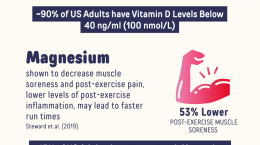Published on March 25, 2025
Written by
 The International Society of Sports Nutrition (ISSN) is a well-known academic society that promotes the science and application of evidence-based sports nutrition and supplementation. Most recently, the organization published a position statement that includes official conclusions on the effects of omega-3 supplementation on exercise performance, recovery, and brain health in young, healthy populations based on the critical assessment of the evidence. This article will provide an overview of the position and its findings.
The International Society of Sports Nutrition (ISSN) is a well-known academic society that promotes the science and application of evidence-based sports nutrition and supplementation. Most recently, the organization published a position statement that includes official conclusions on the effects of omega-3 supplementation on exercise performance, recovery, and brain health in young, healthy populations based on the critical assessment of the evidence. This article will provide an overview of the position and its findings.
Omega-3 Overview
Polyunsaturated fatty acids (PUFAs) are fatty acids that have two or more double bonds in their fatty acid chain. The two main classes of PUFAs are omega-3, named for their first double bond on the third carbon, and omega-6s, named for their first double bond on the sixth carbon. Omega-3 fatty acids, particularly long-chain omega-3 PUFAs eicosapentaenoic acid (EPA) and docosahexaenoic acid (DHA), have attracted attention from the scientific and clinical communities for their unique properties and health benefits.
BLOG: Can Athletes Benefit from Taking More EPA and DHA?
Omega-3s play functionally essential roles in human physiology. They embed in the phospholipid bilayer of cellular membranes and are critical to cell structure and function. From there, they act as precursors to various bioactive molecules that provide anti-inflammatory, anti-arrhythmic, and antithrombotic properties.
Therefore, they have been found to exert protective effects on cardiovascular, retinal, musculoskeletal, cerebrovascular, and neural systems. Beyond these health outcomes, omega-3s have been found to support athlete health and performance in a variety of ways, such improving exercise economy, supporting immune health, enhancing recovery, and providing cognitive support and protection.
VIDEO: Which Omega-3 is Good for Sports? (5 Benefits for Athletes)
Summary of ISSN Consensus and Findings
ISSN: Athletes appear to be at high risk for omega-3 insufficiency. Yet, practical strategies exist for increasing individual omega-3 levels, such as increasing intake through EPA-rich and DHA-rich food sources or supplementation.
Research indicates that athletes are at risk for omega-3 inadequacy. And although DHA and EPA can be synthesized from other fatty acids, like alpha-linolenic acid (ALA) commonly found in nuts and seeds, conversion rates are very low. Evidence indicates that the conversion of ALA to EPA is approximately 5-10%, and ALA to DHA is only 2-5%. Therefore, EPA and DHA are considered “conditionally essential,” and direct sources of DHA and EPA are likely necessary to obtain adequate amounts of these nutrients.
However, EPA and DHA food sources are limited primarily to oily fish, like salmon, mackerel, sardines, and herring. There are many potential reasons young, athletic populations do not consume enough food rich in EPA and DHA, such as cost, taste preference, access, or lack of required cooking skills. For these reasons, omega-3 supplementation may be necessary to meet individual athlete needs. Fortunately, increasing omega-3s in the diet, whether through food or supplementation, is effective at raising omega-3 levels in young, healthy populations.
ISSN: EPA and DHA supplementation has been shown to enhance endurance capacity and cardiovascular function during aerobic exercise.
Omega-3 supplementation results in the incorporation of omega-3s into skeletal and myocardial muscle membranes in as little as 2 weeks. Once incorporated, omega-3s can improve cardiac remodeling and influence aerobic-related organelles, such as the sarcolemma and mitochondria. By influencing these organelles, omega-3s can improve running economy, aerobic metabolism and capacity, and cardiovascular function during endurance exercise. Endurance athletes may benefit from optimal omega-3 levels.
BLOG: Can Omega-3s Improve Your Run?
ISSN: Omega-3 supplementation may not confer hypertrophic benefits, but when combined with resistance training, it may improve strength in a dose- and duration-dependent manner.
In addition to aerobic metabolism and performance, omega-3s have been found to influence muscle metabolism and performance. It’s been well documented that omega-3s positively influence muscle function and strength in older adults. Yet, the outcomes in young adults remain less clear.
Evidence to date does not support a hypertrophic benefit for omega-3 fats. Similarly, there appear to be no effects on muscular power. However, studies on the effects of omega-3s on muscular strength show promise. Some studies have reported that omega-3 tissue status or intake is linked to improved strength. It’s hypothesized that improvements in strength are due to neuromuscular benefits. However, others have shown no improvements. More high-quality research is warranted to make definitive conclusions and recommendations regarding omega-3 supplementation and muscular performance in young adults.
BLOG: Can Omega-3s Combat Frailty in Older Adults?
ISSN: Omega-3 supplementation may enhance exercise recovery by decreasing subjective measures of muscle soreness following exercise.
Several studies have investigated the effects of omega-3s on exercise recovery due to their well-known anti-inflammatory actions. Collectively, studies suggest that omega-3 supplementation may reduce delayed-onset muscle soreness (DOMS) following activity. Yet, the authors also note that although measures of subjective soreness are improved with omega-3s, this does not necessarily translate to objective improvements in proceeding exercise performance. The results demonstrate the effects of omega-3s on performance after exercise-induced muscle damage are mixed. But so are the study methodologies. Therefore, although omega-3s may reduce subjective measures of muscle soreness, their effects on objective markers of recovery and performance need further exploration before definitive conclusions can be made.
BLOG: Can Athletes Benefit from Taking More EPA and DHA?
ISSN: Omega-3s can positively affect immune responses in athletic populations.
Athletes participating in high volumes of intense training can develop a compromised immune system, increasing the likelihood of infections that get in the way of their training and performance. Omega-3 metabolites, collectively known as specialized pro-resolving mediators (SPMs), influence innate and adaptive immunity.
In general, omega-3s can decrease macrophage cytokine expression, increase macrophage and neutrophil phagocytosis, enhance microbial clearance, and decrease activation of various immune cells. Many studies conducted in athletic populations found that omega-3 influences the production and regulation of various inflammatory cytokines, supporting the immune health of the athlete.
BLOG: Omega-3 Index and Immune System Balance
ISSN: Omega-3 supplementation may enhance sleep quality and provide additional neuroprotective benefits to athletes susceptible to head impacts. Further research is needed to explore the effects of omega-3 on cognition and sleep in young, healthy populations.
Over half of the brain’s composition encompasses lipids, and increased incorporation of omega-3 PUFAs may affect cognitive health and functioning. DHA is found in high concentrations in neuronal cells, contributing to brain function and membrane integrity, and with EPA, provides anti-inflammatory fortification.
Although limited, a growing body of evidence indicates that prophylactic omega-3 supplementation may offer neuroprotective benefits in athletes susceptible to head impacts. This is reflected in a 2024 meta-analysis demonstrating preliminary support for the prophylactic administration of LC ω-3 PUFA in contact sport athletes exposed to repetitive sub-concussive head impacts.
Additionally, some evidence has found that omega-3s may improve sleep quality, acting on neurotransmitters that help regulate sleep, such as dopamine and serotonin. However, inconsistency in results indicates that more research is needed to fully understand the relationship between omega-3s and sleep.
Finally, the authors found that while research demonstrates that omega-3 supplementation can increase membrane fluidity, neurotransmitter synthesis and release, and cerebral blood flow, research in young and healthy athletes is limited, and more research is needed to determine if there are improvements in sport-specific cognitive function.
BLOG: Omega-3s and Brain Health in Contact Sports
ISSN: Omega-3s are classified as prebiotics, but more research is needed to fully understand their effects on the gut microbiome and gut health in athletes.
Exercise-induced gastrointestinal symptoms are common amongst athletes. In endurance athletes, the prevalence of gut symptoms can reach up to 70%. During exercise, blood is redirected from the gut, opening tight junctions in the gut lining and triggering increased inflammation and gut dysbiosis.
Omega-3s are a prebiotic, a substrate selectively utilized by host microorganisms, conferring a health benefit. The authors note that omega-3 intake and circulating levels have been linked with improvements in gut microbiome. However, more studies are needed to determine the effects of omega-3s on the gut health of exercising athletes.
Conclusion
The ISSN position statement provides a consensus regarding the effects of supplemental omega-3 fats in healthy and athletic populations. The recently published paper highlighted the need for further research in young and active populations. However, early evidence suggests that athletes are at high risk for omega-3 insufficiency and may benefit from supplementation.
Omega-3s may enhance athlete health and performance by improving aerobic exercise, strength, recovery, immunity, gut health, sleep quality, and neuroprotection. The omega-3 index, which measures the percentage of EPA + DHA in red blood cell membranes, is the standard biomarker for assessing omega-3 adequacy. Evaluating omega-3 status among young and healthy populations and increasing omega-3 intake accordingly may help athletes optimize their health and performance.
How Are Your Omega-3 Index, Vitamin D Status, and Other Important Health Markers?
Check your vitamin D, omega-3s, magnesium, and other important markers today as part of the vitamin D*action project!
Measure your:
- Vitamin D
- Magnesium PLUS Elements (including zinc, copper, selenium, mercury, cadmium and lead)
- Omega-3 Fatty Acids
- hsCRP (for Inflammation)
- HbA1c (for Blood Sugar)
- and more
Did you know that each of the above can be measured at home using a simple blood spot test? As part of our ongoing research project, you can order your home blood spot test kit to get your levels, followed by education and steps to take to help you reach your optimal target levels. Start by enrolling and ordering your kit to measure each of the above important markers, and make sure you are getting enough of each to support better health and wellbeing!
Start Here to Measure Your Levels





